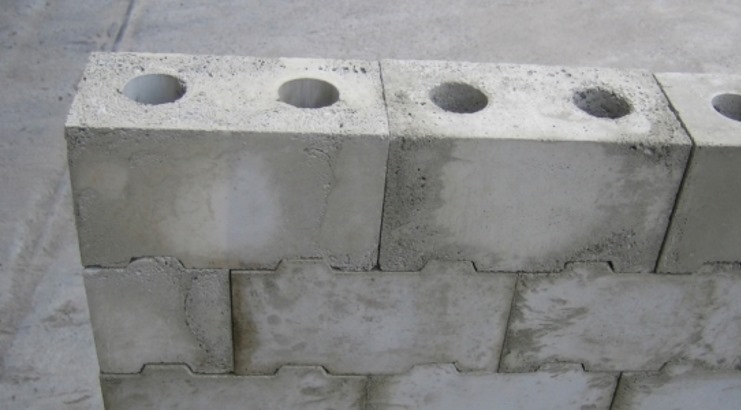Materials & Supplies
ABCs of Interlocking Blocks
Interlocking blocks are made using a soil block press machine.

Interlocking blocks are accelerating the construction of low-cost houses in Kenya, with more builders embracing the technique that lowers building costs by up to 60%.
The technique involves the production of bricks that interlock with each other during construction, thereby eliminating the need for mortar to bind the building.
The interlocking blocks are made using soil block press (SBP) machines that compress a mixture of sifted soil, water, and cement to produce solid blocks.
Cement, which makes up 3% of the blocks, is mixed with any type of soil (except black cotton soil) and water. The mixture is then compressed to produce interlocking blocks.
The cement-to-soil ratio varies depending on the soil type and can be determined by testing the available soil for shrinkage.
Types of Interlocking Blocks
Interlocking blocks are grouped into two main categories based on the material they are made from concrete blocks and stabilized soil blocks.
Concrete blocks can also be further classified into two varieties:
a. Rough-finished blocks: These interlocking blocks feature a rough surface finish due to the composition of the mix used in their production. Their advantage lies in their rapid production, which results in a more affordable price point.
They suit various construction scenarios, although additional plastering might be necessary to achieve smooth surfaces.
b. Smooth interlocking blocks: Crafted from robust concrete and subjected to vibration for a sleek appearance, these blocks offer a smooth surface that’s conducive to painting. While they enhance aesthetics, they tend to be pricier compared to the rough-finished blocks.
Another prevalent block type is earthen blocks, which can be fabricated from pure soil and water, fired, or stabilized using cement or lime, eliminating the need for kiln firing.
Some of these blocks might be designed as hollow to minimize material consumption and reduce overall block weight.
Advantages of interlocking blocks
- Provide bearing strength: Interlocking blocks possess sufficient bearing strength, rendering them suitable for constructing single-story buildings.
- Accelerate construction: The absence of the need to wait for mortar to dry expedites the construction process.
- Offer thermal and sound insulation: Many interlocking blocks, particularly hollow variants, offer remarkable thermal insulation and soundproofing.
- Demonstrates cost-effectiveness: Interlocking blocks prove more economical compared to traditional masonry techniques.
Disadvantages of interlocking blocks
- Limited load-bearing: Using interlocking blocks as load-bearing walls in tall structures is not advisable without engineering supervision.
- Seepage vulnerability: In extreme weather conditions, improper joint protection might result in water seepage. Addressing this involves sealing joints during construction using a cement-water paste—first dipping the block and then assembling.
- Plastering importance: If left without plastering, these blocks can develop cracks and crevices that provide refuge for insects.
Interlocking blocks machine
The SBP machine retails for about Sh100,000.
It is manually operated and can produce 400-500 blocks a day, with the average interlocking bricks price in Kenya set at Sh13.50 per piece.
“All blocks are tested for strength and durability by the Kenya Bureau of Standards and the University of Bath, UK; [and] results show that blocks made with Makiga machines are 82% stronger than a clay-fired brick,” Makiga Engineering Services says on its website.
Makiga is one of the many local and foreign companies that have invested heavily in the provision of low-cost housing solutions in Kenya through the production of affordable interlocking building blocks.
Others include the National Housing Corporation (NHC), Mabati Rolling Mills, US-based International Green Structures (IGS) and China’s Blue Sky International.
NHC has invested Sh1 billion in the construction of a prefabs factory in Machakos County, with a capacity to produce 126,720 expanded polystyrene panels a year.
In 2014, IGS unveiled a Sh851,400 house built using panels made from compressed wheat husks, targeting low-income earners, while Blue Sky later announced plans to build a Sh1 billion prefab materials factory in Machakos.
Since the cost of building a house with interlocking bricks is quite affordable, many homeowners are now embracing the technique, sparking a new trend that is likely to bridge the housing demand-supply gap in the country.
FAQ
What are interlocking blocks?
Interlocking blocks are bricks made using a machine that compresses a mixture of soil, water, and cement to produce building blocks.
Most interlocking blocks are made with rims that slip over the rear edge of the preceding course. Others rely on a system of pins.
What is interlocking in construction?
This entails the use of interlocking blocks to put up a structure. The bricks are fashioned in such a manner that they lock themselves to each other without the use of mortar.
How much do interlocking blocks cost in Kenya?
The cost of interlocking blocks varies depending on various factors of production. However, the price of a single block is between Sh12 and Sh15.
Interlocking bricks are often 125 mm x 250 mm x 100 mm in size, and about 40 blocks are required to build a square metre of wall.
This puts the cost at Sh600 per square metre.














